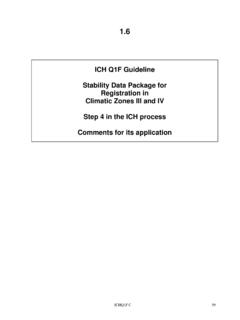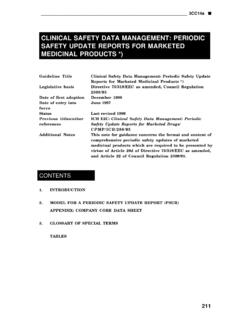Transcription of 32 1.4 Stability Workshpo ICH Q1D C - IKEV
1 ICHQ1D C ICH Q1D Guideline Bracketing and Matrixing Designs for Stability Testing of New Drug Substances and Products ICH Step 4 Comments for its application ICHQ1D C 43 1. Introduction Objectives of the Guideline Recommendations for application of bracketing and matrixing Background Q1A(R2) mentions only possibility Scope of the Guideline Guidance on study designs Specific priniciples for applications Sample designs for illustrative purposes 2. Guidelines General Full study design: samples for every combination, all design factors tested at all time points Reduced design ability to adequately predict retest period or shelf life Risk assessment, shorter shelf life possible Change to full testing or less reduced design can be considered.
2 If changed full testing or less reduced testing through remaining time points. Applicability of Reduced Designs Applicable to formal Stability studies of most types of drug products Drug substances: matrixing limited, bracketing generally not applicable Whether bracketing or matrixing depends on circumstances Any reduced design should be justified. Type and level of justification depends on avaiable supporing data. Careful consideration and scientific justification, if bracketing and matrixing in one design. Bracketing Bracketing is the design of a Stability schedule such that only the extremes of certain design factors are tested al all time points - different strengths - different container size and/or fill Stability of intermediate levels represented by Stability or tested extremes.
3 Bracketing design not appropriate, if tested samples are not the extremes. Rationale for bracketing - Interpolation between extremes is logical - Useful where lage number of presentations - Fairly well accepted ICHQ1D C 44 Design Factors Design factors are variables to be evaluated for their effect on product Stability Strengths Applicable without justificationt to studies with multiple strengths with identical or closely related formulations - Capsules of different strengths with different plug size same powder blend - Tablets different strengths compressing varying amounts of same granulation - Oral solutions of different strenghts with formulations that differ only in minor - excipients ( , colourants, flavourings)
4 Applicable with justification to studies with multiple strengths where relative amounts of drug substance and excipients change in a formulation. Justification means that corresponding supportive data on the drug product are available, Stability profiles of different strengths of clinical or development batches. If results indicate that different strengths, even with different compositions do not differ in Stability behabiour justification is easy. Bracketing not applicable if different excipients are used amoung strengths. Container Closure Sizes and/or Fills Applicable without justificationt for same container closure systemn where either size of fill varies If both container size and fill vary, largest or smallest containers may not represent the extremes of all packaging configurations.
5 Extremes should be selected comparing various characteristics: - Container wall thickness - Closure geometry, - Surface area to volume ratio, - Headsspace to volume ratio, - Water vapour permeaton rate per dosage unit With justificaton applicable with same container but closure varies If investigations for physico-chemical Stability for solid dosage forms have shown not sensitive to moisture, liquid dosage forms not senitive to oxygen, justificaton is easy. Design Considerations and Potential Risks If during testing one of extremes no longer expected to be marketed, study maintained to support bracketing intermediates. Commitment post approval Stability testing. If Stability of extremes differ, intermediates not exceed least stable extreme.
6 ICHQ1D C 45 Design Example Three strengths, three container sizes Dosage Strength Container size 50 mg 75mg 100mg 1 2 3 1 2 3 1 2 3 HDPE/ 15ml T T T T T T HDPE/ 100ml HDPE/ 500ml T T T T T T T means sample is tested Design Considerations and Potential Risks II
7 To reduce the risk applying bracketing the number of strengths or container sizes should be balanced with the total number of strengths or container sizes. This should be especially considered if bracketing is applied during the development stage of the drug product. Therefore the following general rules are fixed. NUMBER OF STRENGTHS STRENGTHS TO BE TESTED 1-2 all 3-4 lowest and highest 5+ lowest, middle, highest NUMBER OF SIZES SIZES TO BE TESTED 1-2 smallest 3-4 smallest , biggest 5+ smallest, middle.
8 Biggest ICHQ1D C 46 Savings by Bracketing Full testing Bracketing Strengths Container Sizes Batches Total Batches Total timePoints StrengthsContainerSize Batches Total Batches Total timePoints savings 1 1 3 3 36 - - - - - - 2 1 3 6 72 - - - - - - 3 1 3 9 108 2 1 3 6 72 33% 3 2 3 18 207 2 1 3 6 72 65% 3 3 3 27 306 2 2 3 12 138 55% 4 1 3 12 144 2 1 3 6 72 50% 4 2 3 24 276 2 1 3 6 72 74%
9 4 3 3 36 408 2 2 3 12 138 66% Matrixing As defined in the glossary to the parent guideline, matrixing is the design of a Stability schedule such: that a selected subset of the total number of possible samples for all factor combinations is tested at a specified time point. At a subsequent time point, another subset of samples for all factor combinations is tested. The design assumes that the Stability of each subset of samples tested represents the Stability of all samples at a given time point.
10 The differences in the samples for the same drug product should be identified as, for example: covering different batches, different strengths, different sizes of the same container closure system, possibly in some cases, different container closure systems. Design Factors Matrixing application without justification: Strengths with identical or closely related formulations as - capsules of different strengths made with different fill plug sizes from the same powder blend, - tablets of different strengths manufactured by compressing varying amounts of the same granulation, - formulations that differ only in minor excipients, colorants, flavourings Batches made using the same process and equipment, Container size and fill in the same closure system.







